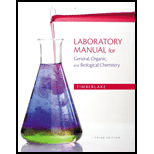
Concept explainers
a.
To match:
The metabolic
Introduction:
Nucleotides are the building blocks of the
b.
To match:
The metabolic nucleotide that matches with the description “exchanges energy when
Introduction:
Nucleotides are the building blocks of the nucleic acids such as deoxyribo nucleic acid (DNA), and ribonucleic acid (RNA). These nucleotides have significant metabolic functions in cells, therefore, called as “metabolic nucleotides”. They act as energy exchanger and can also be coenzymes. Metabolic nucleotides have two forms: a high energy form and a low energy form.
c.
To match:
The metabolic nucleotide that matches with the description “the oxidized form of Flavin adenine dinucleotide”
Introduction:
Nucleotides are the building blocks of the nucleic acids such as deoxyribo nucleic acid (DNA), and ribonucleic acid (RNA). These nucleotides have significant metabolic functions in cells, therefore, called as “metabolic nucleotides”. They act as energy exchanger and can also be coenzymes. Metabolic nucleotides have two forms: a high energy form and a low energy form.
Want to see the full answer?
Check out a sample textbook solution
Chapter 12 Solutions
EBK LABORATORY MANUAL FOR GENERAL, ORGA
- 0 What are the structural differences between vitamin C and sugars? Do these structural differences play a role in the susceptibility of this vitamin to air oxidation?arrow_forwardplease answer the question and provide explanationarrow_forwardAn important step in the glycolysis pathway for catabolizing glucose is the hydride transfer from an hemithioacetal to the acceptor NAD*. Indicate with curved arrows the flow of electrons in this step. Enzyme Enzyme BH* B: H H-O-H H- OH `NH2 H- -OH NH2 CH,OPO,2 CH,OPO, Hemithioacetal Thioesterarrow_forward
- The standard free energy change (ΔG°') for hydrolysis of fructose-l,6-bisphosphate (FBP) to fructose-6-phosphate (F-6-P) and Pi is -16.7 kJ/mol: FBP + H2O → Fructose-6-P + Pi The standard free energy change (ΔG°') for ATP hydrolysis is -30.5 kJ/mol: ATP + H2O → ADP + Pi a What is the standard free energy change for the phosphofructokinase reaction: ATP + Fructose-6-phosphate → ADP + FBP ΔG°' = -13.8 kJ/mol b What is the equilibrium constant for this reaction at 25.0 °C? K'eq =arrow_forwardFill in the box to complete the reactions:arrow_forwardPh3P C4H9LI Br an intermediatearrow_forward
 Introduction to General, Organic and BiochemistryChemistryISBN:9781285869759Author:Frederick A. Bettelheim, William H. Brown, Mary K. Campbell, Shawn O. Farrell, Omar TorresPublisher:Cengage Learning
Introduction to General, Organic and BiochemistryChemistryISBN:9781285869759Author:Frederick A. Bettelheim, William H. Brown, Mary K. Campbell, Shawn O. Farrell, Omar TorresPublisher:Cengage Learning World of Chemistry, 3rd editionChemistryISBN:9781133109655Author:Steven S. Zumdahl, Susan L. Zumdahl, Donald J. DeCostePublisher:Brooks / Cole / Cengage Learning
World of Chemistry, 3rd editionChemistryISBN:9781133109655Author:Steven S. Zumdahl, Susan L. Zumdahl, Donald J. DeCostePublisher:Brooks / Cole / Cengage Learning Chemistry & Chemical ReactivityChemistryISBN:9781133949640Author:John C. Kotz, Paul M. Treichel, John Townsend, David TreichelPublisher:Cengage Learning
Chemistry & Chemical ReactivityChemistryISBN:9781133949640Author:John C. Kotz, Paul M. Treichel, John Townsend, David TreichelPublisher:Cengage Learning Principles of Modern ChemistryChemistryISBN:9781305079113Author:David W. Oxtoby, H. Pat Gillis, Laurie J. ButlerPublisher:Cengage Learning
Principles of Modern ChemistryChemistryISBN:9781305079113Author:David W. Oxtoby, H. Pat Gillis, Laurie J. ButlerPublisher:Cengage Learning Chemistry for Today: General, Organic, and Bioche...ChemistryISBN:9781305960060Author:Spencer L. Seager, Michael R. Slabaugh, Maren S. HansenPublisher:Cengage Learning
Chemistry for Today: General, Organic, and Bioche...ChemistryISBN:9781305960060Author:Spencer L. Seager, Michael R. Slabaugh, Maren S. HansenPublisher:Cengage Learning Introductory Chemistry: An Active Learning Approa...ChemistryISBN:9781305079250Author:Mark S. Cracolice, Ed PetersPublisher:Cengage Learning
Introductory Chemistry: An Active Learning Approa...ChemistryISBN:9781305079250Author:Mark S. Cracolice, Ed PetersPublisher:Cengage Learning





